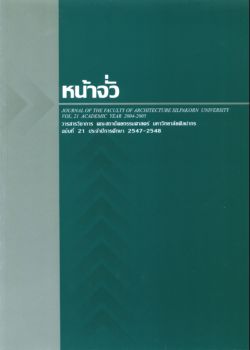สภาวะน่าสบาย : พื้นฐานและแบบจําลองสําหรับภูมิอากาศเขตร้อนชื้น
Keywords:
สภาวะน่าสบาย, ภูมิอากาศเขตร้อนชื้น, เขตสภาวะน่าสบาย, แบบจําลองแบบตายตัว, แบบจําลองแบบปรับได้, Thermal comfort, Hot and humid climates, Comfort zone, Static model, Adaptive modelAbstract
บทความนี้ปูพื้นฐานความรู้เรื่องสภาวะน่าสบายทางอุณหภูมิเพื่อการออกแบบอาคารในเขตร้อนชื้น โดยเสนอ คำจำกัดความของสภาวะน่าสบายทางอุณหภูมิ, ดัชนีวัดสภาวะน่าสบายทางอุณหภูมิ, เขตสภาวะน่าสบายทางอุณหภูมิ, และแบบจําลองสภาวะน่าสบายทางอุณหภูมิ โดยเฉพาะแบบจําลองแบบตายตัว (static or constancy model) ของ Fanger ที่เรียกว่า PMV และ (Adaptive model) บทความนี้ยังนําเสนองานวิจัยที่มุ่งเน้นแบบจําลองสองแบบนี้ในด้านความสัมพันธ์กับการปรับตัวทางอุณหภูมิ และการนําไปใช้ในการออกแบบอาคารให้เกิดสภาวะน่าสบายทางอุณหภูมิ ในขณะที่แบบจําลอง PMV คํานึงถึง 4 ตัวแปรทางกายภาพ (อุณหภูมิอากาศ, ความเร็วลม, อุณหภูมิเฉลี่ยจากการแผ่รังสีความร้อน และความชื้นสัมพัทธ์) และ 2 ตัวแปรบุคคล (เครื่องแต่งกาย และระดับกิจกรรม) โดยไม่เน้นความสําคัญของสภาพแวดล้อมภายนอก ซึ่งนําไปสู่การควบคุมสภาวะภายในอาคารที่พึ่งพาระบบปรับอากาศทางกล แบบจําลองแบบปรับได้กลับสนับสนุนการแปรเปลี่ยนของอุณหภูมิภายในและความสามารถในการปรับตัวทางอุณหภูมิของผู้ใช้อาคาร อันนําไปสู่การขยายขอบเขตความสบายของผู้ใช้อาคารและแนวทางในการออกแบบตามสภาวะแวดลัอมและการประหยัดพลังงาน บทความนี้ได้เสนอเขตสภาวะน่าสบายทางอุณหภูมิสําหรับประเทศไทยโดยใช้แบบจําลองแบบปรับได้
Thermal comfort : Basics and Models for Hot and Humid Climates
This article gives a basic knowledge of thermal comfort for building design in hot and humid climates including the definition of thermal comfort, thermal indices, thermal comfort limit, and models of thermal comfort and preference, in particular, the static or constancy model, Fanger's Predicted Mean Vote (PMV), and the adaptive model. It reviews some research works focusing on the two models which show their relations to thermal adaptation and the implications of the models for thermal design of buildings. Whilst the PMV model combining four physical variables (air temperature, air velocity, mean radiant temperature, and relative humidity), and two personal variables (clothing insulation and activity level) with minimal recognition of outdoor climatic context contributes to a reliance on mechanical cooling to control indoor conditions, the adaptive model advocates the variation in indoor temperature and thermal adaptation of building occupants, thus enhancing the occupants’ comfort limit and leading to environmentally responsive design and reducing energy consumption. In this article, the comfort zone for Thailand was proposed using the adaptive model.




